Itinerary 1: The
Northern Route
through the
C&D
Canal
, down
Delaware Bay
and out to Montauk, or skipping along the coast
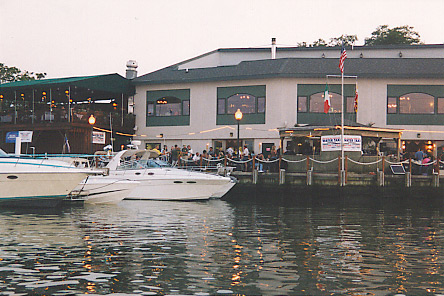
The Chesapeake Inn at the "C" entrance to the C&D Canal
This route allows you to avoid overnight passages on the ocean or combine some offshore time with day sails. If you are uncomfortable with sailing the coast at night, this is the route for you.
The 14-mile long
C&D
Canal
connects
Chesapeake Bay
with
Delaware Bay
and cuts about 300 miles off the trip from the northern
Chesapeake
to the
Atlantic Ocean
and other Eastern cities. It is one of the few fully sea-level shipping canals in the world. There are six bridges as it crosses the
DelMarVa Peninsula
, with a charming town,
Chesapeake City
,
MD
on the western end and
Reedy Point
,
DE
to the east. The
C&D
Canal
itself is quite a pleasant journey although you are not permitted to sail, only motor.
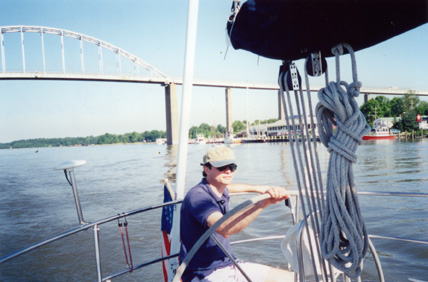
C&D Canal with Schaefer's Canal House in the background
The original
C & D
Canal
was built privately in the 1820s. When it opened for business in 1829, it had 10 feet of water depth and four locks. Barges and sailing vessels were towed by teams of mules and horses. It was later purchased by the government and modified several times. By the mid 1970s, further projects increased the channel depth to 35 feet and the channel width to 450 feet, which is adequate for two-way traffic for most oceangoing ships. The upper
Chesapeake Bay
dredged channel was also deepened to 35 feet, in conjunction with the last set of projects, ensuring safe passage of commercial traffic through this important artery.
The amount of traffic transiting the Canal today is staggering. It is a commercial shipping channel that enables passage of cargo from the ports of
Baltimore
,
Washington
, and
Philadelphia
between the
Chesapeake
, the
Delaware
, and the
Atlantic
. If you want to see something cool, check out the military website that monitors the passage of ships through the canal. https://candd.nap.usace.army.mil/
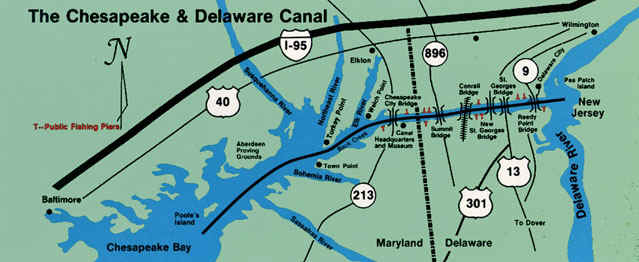
Courtesy of the Army Corps of Engineers
Be prepared that you will be sharing the Canal with behemoth vessels that have limited maneuverability. You must always give way to them. Review the Rules of the Road beforehand.
We started out from Havre de Grace very early in the morning to catch a favorable tide. We were in a “deep water” slip and were told there was “plenty of water” under our 7.5 foot keel. So we did our last minute errands then prepared to shove off. We shoved and revved and nothing happened. We were firmly within the grips of the
Chesapeake
mud monster. Finally, Alex gunned the engine one more time and we broke free to the cheers of the bystanders.
Waiting out the tide for transiting the C&D Canal & Delaware Bay
|
So depth is an issue in the
Upper Chesapeake
. And although the tidal range is small (~2 feet) by comparison to what we are now used to, it can make a difference, especially when it comes to the currents associated with it. For the Canal it is not as much of an issue, but the current on the
Delaware Bay
requires some planning if you want to make headway. The trick is in timing the passage through the Canal so you can have a favorable current with you the entire way down the
Delaware Bay
.
Luckily, there are several nice places to wait out the tide at the head of the Bay when heading from
Maryland
to
Delaware
. We already mentioned Havre de Grace, which is on the
Western
Shore
and a straight shot across to the Canal. The Tidewater Marina there is topnotch. Perhaps the best place to wait out the tide is the Chesapeake Inn Restaurant and
Marina
right in
Chesapeake
City
. The outdoor restaurant seating area is a great place to watch the ships going by and get a sense of the traffic patterns. The town is delightful and offers a historic setting for a stroll to pass the time.
Going in the other direction (DE to MD), the best staging area is at
Cape May
in
New Jersey
. This is a terrific anchorage, with Coast Guard facilities, restaurants, and marinas, all standing by for your visit.
Delaware Bay
is not terribly scenic, is riddled with giant ship traffic, has few anchorages and a hellish current which can top 5 knots. Currents can greatly influence both your forward progress and your fuel consumption. Basically, if you are on a sailboat and transiting against the tide, it’ll be a long trip because at best you’ll be standing still for hours. If you have a powerboat and can muscle against the current, you’d better have plenty of fuel.
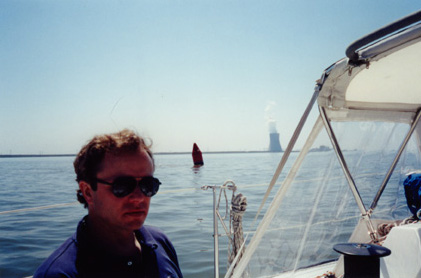
The lower Delaware Bay. It not very scenic. The tide had turned as you can see from the buoy.
The
Delaware River
and Bay is rather industrial and boring, and there is typically a lot of flotsam, so a diligent skipper is a must (particularly if you're in a fast moving power boat). This part of the trip was simply a transit. We decided to make a stop in
Cape May
so I could show Alex a bit of this charming Victorian seaside town and rest up before the offshore passage. We anchored right off the Coast Guard station then dinghied over to the Lobster House at Fisherman’s Wharf, the traditional seafood restaurant in
Cape May
. As usual, it was brimming with patrons both indoors and out. After a nice dinner, a lovely stroll along the waterfront, and a good night’s rest, we were ready for our offshore passage.
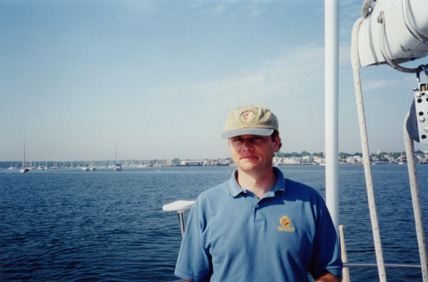
Leaving Cape May, NJ
We headed out the following morning in a nice SW 15 knot breeze and set a course for Montauk. Alex and I sail short handed routinely and have developed a watch schedule of 3 hours on, 3 hours off, which suits us well but certainly is not for everyone. What that means is that through the night, one is alone on deck while the other is sleeping. We keep a close watch and have an agreement that:
- At night, we always wear lifejackets and harnesses with tethers secured at all times, even in the cockpit.
- If something requires attention forward, we call the other to assist.
- We do not change sails or reef alone.
- If there is any question at all about anything, whether navigation, or passing ships, or weather, etc, we wake the other for conference.
In both cases we were quite lucky with weather, and somewhat unlucky with things going bump in the night (which will be the subject of another story).
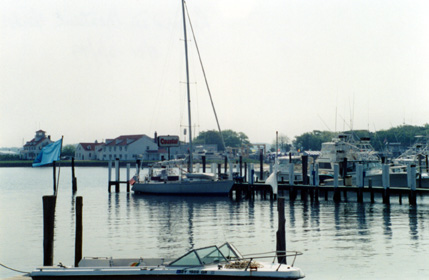
Snug in Montauk, NY at the tip of Long Island.


